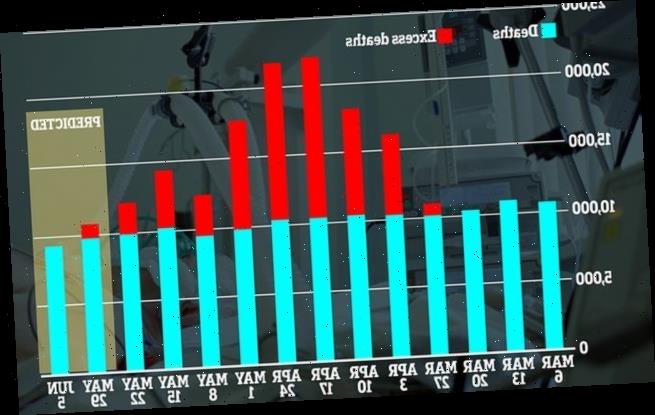Revealed: The areas of England and Wales that have recorded the highest rate of ‘excess deaths’ during the coronavirus pandemic
- The London borough of Brent saw a 108 per cent increase in deaths of any cause
- A total 17 out of the 20 worst-hit areas were boroughs of London
- The data counts the number of people who have died between January and May
- In some rural areas, including Devon, Lincolnshire and Wales, deaths had fallen
- Here’s how to help people impacted by Covid-19
The coronavirus pandemic has driven up death rates in some parts of London to double what they are in a usual year, data has revealed.
Statistics show that the number of people who died in the first five months of 2020 was massively increased across the country by the Covid-19 epidemic.
The Office for National Statistics yesterday revealed that at least 56,000 ‘excess deaths’ have been recorded in England and Wales alone.
And while not all of these people have been direct victims of the coronavirus, many have died as a result of indirect impacts of the outbreak, such as reduced hospital services.
Brent, in London, is the worst affected part of Britain by this measure, with the number of people dying there soaring from 447 in January-May in an average year to 925 this year. That is an increase of 108 per cent.
Data analysed by The Telegraph shows that 17 out of the 20 worst affected places across the UK are all boroughs of the capital.
Others that saw their death rate approximately double were Harrow (99.7 per cent increase), Newham (95.4 per cent) and Enfield (90.3 per cent).
The highest increase in deaths outside of London was seen in Hertsmere in Hertfordshire, where fatalities rose by 86.2 per cent from 236 to 439.
Separate data published yesterday showed that Birmingham has seen the highest number of deaths directly caused by the coronavirus, with 1,082 victims.
This was followed by Leeds (605), County Durham (567) and Liverpool (529). The overall deaths statistics suggest smaller proportions of those populations were affected by the epidemic.
The number of excess deaths in England and Wales spiked dramatically during the peak of the coronavirus outbreak. Professor Carl Heneghan, an Oxford University epidemiologist, predicted that the number of people dying would fall to average levels again by July
Separate data published yesterday showed that Birmingham has recorded the most deaths of diagnosed coronavirus patients, with 1,082 victims
The data includes people who died of any cause between January 1 and May 22, or up to May 24 in Scotland.
More than a dozen areas in England and Wales actually appeared to be unaffected by the virus and saw the numbers of people dying fall to lower-than average levels.
In North East Lincolnshire the death rate dropped by 8.8 per cent, while it fell by 8.2 per cent in Conwy, Wales, and by five per cent on Anglesey, off the Welsh coast.
Excess deaths are considered to be an accurate measure of the number of people killed by the pandemic because they include a broader spectrum of victims.
As well as including people who may have died with Covid-19 without ever being tested, the data also shows how many more people died because their medical treatment was postponed, for example, or who didn’t or couldn’t get to hospital when they were seriously ill.
Experts are divided, however, on how accurate excess deaths are as a measure.
Oxford University’s Professor Carl Heneghan yesterday said that comparing deaths this year to an average taken from the past five years overlooked population growth.
He said the average could have been expected to be higher because there are more people, and more elderly people, in the UK than there were in 2015.
If true, this could mean the impact of the Covid-19 epidemic was overestimated.
Meanwhile, the University of Cambridge’s Professor David Spiegelhalter, argued the measure is still useful.
He said: ‘Deaths this year were tracking pretty close to, but below, the five year average. There is no perfect baseline.
‘I still think [the five-year average] is useful to give an idea of trends, peaks and spikes, but it is not a precise measure.’
Professor Heneghan yesterday said he expects the number of deaths to have returned to normal by next week.
He said: ‘If the trends continue, the deaths look like they will be back to where they should be normally by next week.
‘There’s been a continued reduction in hospital deaths, care home outbreaks are coming down so the “all deaths” by (week) 22 I’m expecting will be back to where we should be.’
Professor Heneghan said there may be no Covid-19 deaths by the end of June – which would follow Spain yesterday. Italy is still reporting between 50 and 100 deaths per day, and France around 30.
‘But it also depends on what happens next, within sporadic outbreaks,’ Professor Heneghan said.
Experts say that unless care home and hospital outbreaks cannot be stopped, deaths caused by the coronavirus will continue at low levels.
Source: Read Full Article


